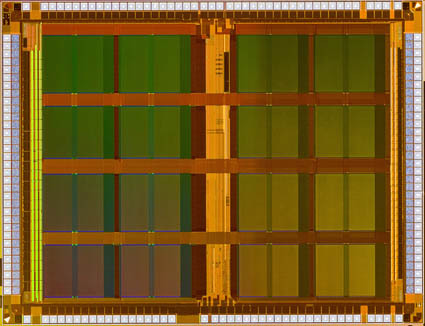Freescale first to put MRAM into mass production
Austin (TX) - Freescale, the former semiconductor arm of Motorola, today announced commercial availability of magneto-resistive random access memory, short MRAM. The technology could become a threat to common memory technologies such as SRAM, DRAM and even Flash, but faces the challenge to catch up with the capacity of its established competition.
Just about two years after the first completed samples, Freescale claims that it has begun offering MRAM in volume quantities. The debut chip, named MR2A16A, is a 4 Mbit (512 kB) device that is organized in 256K words by 16 bits and operates at 3.3 volts - which, according to the manufacturer, allows the device to run in a "commercial temperature range."
MRAM has been considered for at least five years as a potential successor technology for NOR and NAND Flash, both of which are nearing their 20th birthday: Intel was the first company to offer a (256 kb) NOR Flash module back in 1988; Toshiba is credited with inventing NAND Flash. MRAM is promised to combine the non-volatile storage characteristics with the speed of SRAM devices and offer unlimited read/write cycles. Compared to today's NAND Flash - the technology typically used in Flash storage cards - MRAM is about 1 million times faster to write the first bit and about 1000 times faster to read the first bit. Flash has also a limited number of read/write cycles, usually somewhere between 100,000 and 1 million, depending on the device.
The challenge of MRAM is to match the storage density of Flash. Flash still scales very well and remains a moving target for upcoming technologies - not only MRAM, but also ovonics memory (OUM), FRAM, Polymer memory (PFRAM), PCRAM or NRAM (Nanotube RAM). The cell sizes of MRAM are still more than 100 times larger than those of Flash, which explains the fact that we can buy Flash memory chips with capacities of up to 16 GB today and Freescale's new chip comes with "only" half a megabyte space - which is just about 0.003% of the status quo of its assumed competition.
Freescale's MRAM chip MR2A16A
The comparison may not be fair - yet - but the substantial distance is one of the reasons why MRAM isn't aimed at Flash at this time. Instead, Freescale believes that MRAM could become an option to replace (volatile) SRAM modules in portable devices, eliminating the need for a battery to feed the SRAM. "This technology could hasten new classes of electronic products offering dramatic advances in size, cost, power consumption and system performance," Freescale said.
But even in this segment, capacity may become an issue, especially if the premium price tag of MRAM is considered. In a demonstration to prove its capability to manufacture 45 nm devices, Intel announced in January of this year that it has produced a 153 Mbit SRAM chip that carries more than 1 billion transistors on a die with a size of 110 sqmm. The memory cell size of Intel's SRAM is 0.346 μm2 - while most prototypes of recent MRAMs used cell sizes of more than 1 µm2. Freesclae did not disclose the cell size of its first commercial MRAM chip.
Get Tom's Hardware's best news and in-depth reviews, straight to your inbox.
Tom's Hardware is the leading destination for hardcore computer enthusiasts. We cover everything from processors to 3D printers, single-board computers, SSDs and high-end gaming rigs, empowering readers to make the most of the tech they love, keep up on the latest developments and buy the right gear. Our staff has more than 100 years of combined experience covering news, solving tech problems and reviewing components and systems.

